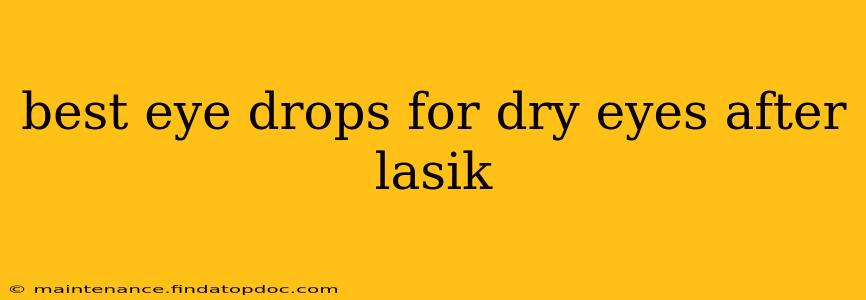LASIK surgery, while remarkably effective in correcting vision, can often lead to temporary—and sometimes persistent—dry eye symptoms. This is because the procedure alters the corneal nerves responsible for tear production and lubrication. Finding the right eye drops can significantly improve comfort and aid in healing. However, it’s crucial to consult your ophthalmologist for personalized recommendations, as the best eye drops for you will depend on the severity of your dry eye and any individual sensitivities. This article will explore common options and address frequently asked questions.
What causes dry eyes after LASIK?
Dry eyes after LASIK are a common side effect due to the surgical disruption of the corneal nerves that regulate tear production and the blink reflex. The procedure can also affect the meibomian glands, which secrete oils that help maintain the tear film's stability. This disruption leads to a reduction in tear quantity and quality, resulting in dry, irritated eyes. The healing process itself also contributes to dryness, as the eyes need time to recover.
What are the best types of eye drops for dry eyes after LASIK?
Several types of eye drops can help alleviate dry eye symptoms after LASIK. Your doctor will likely recommend one or a combination depending on your specific needs:
-
Artificial Tears: These are the most common and often the first line of defense. They mimic the natural composition of tears, providing lubrication and moisture. Look for preservative-free options, as preservatives can sometimes irritate sensitive eyes. Many brands exist, so your ophthalmologist can guide you to one suitable for your eyes.
-
Restasis (Cyclosporine): This prescription medication increases tear production by addressing underlying inflammation. It's generally recommended for more severe cases of dry eye that don't respond adequately to artificial tears.
-
Xiidra (Lifitegrast): Another prescription medication, Xiidra, works by reducing inflammation and improving tear production. Like Restasis, it's a stronger intervention for more persistent dry eye issues.
-
Omega-3 Fatty Acid Supplements: While not eye drops, these supplements can be beneficial in improving the quality of your tear film. They support the health of the meibomian glands and reduce inflammation. Always consult your doctor before starting any new supplements.
How often should I use dry eye drops after LASIK?
The frequency of application depends on the severity of your dry eye and your ophthalmologist's recommendations. It could range from several times a day to only as needed. Follow your doctor’s instructions carefully. Overuse can sometimes lead to unintended consequences.
Are there any eye drops I should avoid after LASIK?
Avoid using any eye drops without first consulting your ophthalmologist. Some eye drops contain preservatives or other ingredients that can interfere with the healing process or irritate your eyes. It's crucial to use only those explicitly recommended by your doctor.
How long will I need to use eye drops after LASIK?
The duration of eye drop use varies depending on individual healing. It can range from a few weeks to several months, or even longer in some cases. Your doctor will monitor your progress and adjust the treatment plan accordingly. Don't stop using prescribed medications without their guidance.
What are the side effects of using eye drops for dry eyes?
Most artificial tears are well-tolerated with minimal side effects. However, some people may experience temporary blurry vision immediately after application or mild stinging or burning. Preservative-containing drops can sometimes cause irritation with prolonged use. Prescription medications like Restasis and Xiidra can have more significant potential side effects, which your doctor will discuss with you before prescribing.
When should I call my doctor about my dry eyes after LASIK?
Contact your ophthalmologist if your dry eye symptoms worsen, become unbearable, or don't improve with the prescribed treatment. Also, contact them if you experience any new or unusual symptoms, such as excessive redness, pain, or changes in vision. Prompt attention can prevent potential complications.
Conclusion:
Managing dry eyes after LASIK is crucial for a comfortable and successful recovery. Remember that this information is for general knowledge only and should not replace professional advice. Always consult with your ophthalmologist for personalized guidance on the best eye drops and treatment plan for your specific needs. They will assess your individual situation and recommend the most appropriate course of action.
